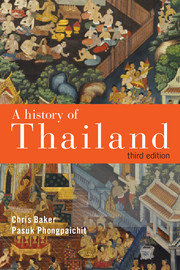Book contents
- Frontmatter
- Contents
- Illustrations
- Preface
- Abbreviations
- Glossary
- Chronology
- 1 Before Bangkok
- 2 The old order in transition, 1760s to 1860s
- 3 Reforms, 1850s to 1910s
- 4 Peasants, merchants, and officials, 1870s to 1930s
- 5 Nationalisms, 1910s to 1940s
- 6 The American era and development, 1940s to 1960s
- 7 Ideologies, 1940s to 1970s
- 8 Globalization and mass society, 1970s onwards
- 9 A political society, 1970s onwards
- Postscript: The strong state and the well-being of the people
- Notes
- Reigns and prime ministers
- Glossary of names
- Readings
- Index
5 - Nationalisms, 1910s to 1940s
Published online by Cambridge University Press: 05 August 2014
- Frontmatter
- Contents
- Illustrations
- Preface
- Abbreviations
- Glossary
- Chronology
- 1 Before Bangkok
- 2 The old order in transition, 1760s to 1860s
- 3 Reforms, 1850s to 1910s
- 4 Peasants, merchants, and officials, 1870s to 1930s
- 5 Nationalisms, 1910s to 1940s
- 6 The American era and development, 1940s to 1960s
- 7 Ideologies, 1940s to 1970s
- 8 Globalization and mass society, 1970s onwards
- 9 A political society, 1970s onwards
- Postscript: The strong state and the well-being of the people
- Notes
- Reigns and prime ministers
- Glossary of names
- Readings
- Index
Summary
In the latter part of his reign, Chulalongkorn and his supporters repeatedly justified the creation of a strong state and its absolutist management on grounds of the need for Siam to progress and be a significant country in the world. This formulation marks the start of one of the two recurring visions in modern Thai politics. The same idea, adapted to changing international and local contexts, would reappear over decades to come. The Chulalongkorn era had also created the key vocabulary of this theme, particularly the notion of samakkhi, unity, and its highly masculine and militaristic imagery exemplified by Chulalongkorn’s equestrian statue, and Damrong’s account of Thai history as a series of wars.
An opposing vision took shape in the early 20th century, in the new urban society created by colonial commerce and by the nation-state itself. Old relationships of patronage were replaced by contracts in the marketplace. People evolved new ideas on human society by reflecting on their own status as independent merchants and professionals, and by grabbing the increasing opportunities to compare Siam to an outside world undergoing tumultuous change. The new men and women of early 20th-century Siam took up the ideas of nation, state, and progress, and recast them. They challenged the definition of the nation as those loyal to the king. They demanded that ‘progress’ be more widely shared. They redefined the purpose of the nation-state as the well-being of the nation’s members.
- Type
- Chapter
- Information
- A History of Thailand , pp. 104 - 138Publisher: Cambridge University PressPrint publication year: 2014



